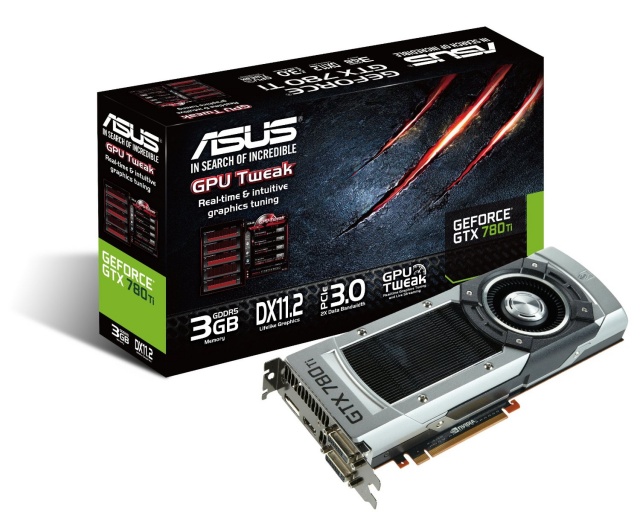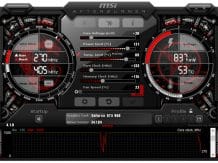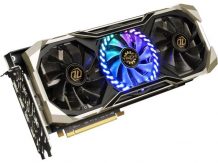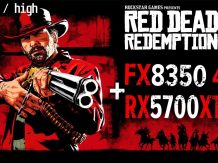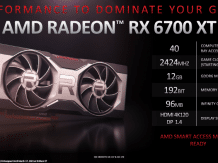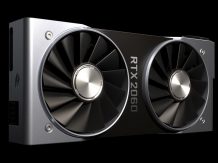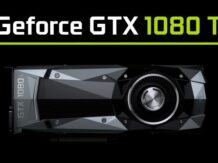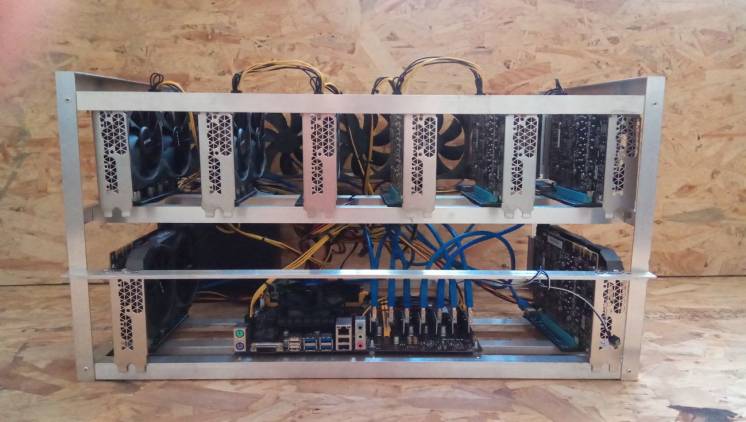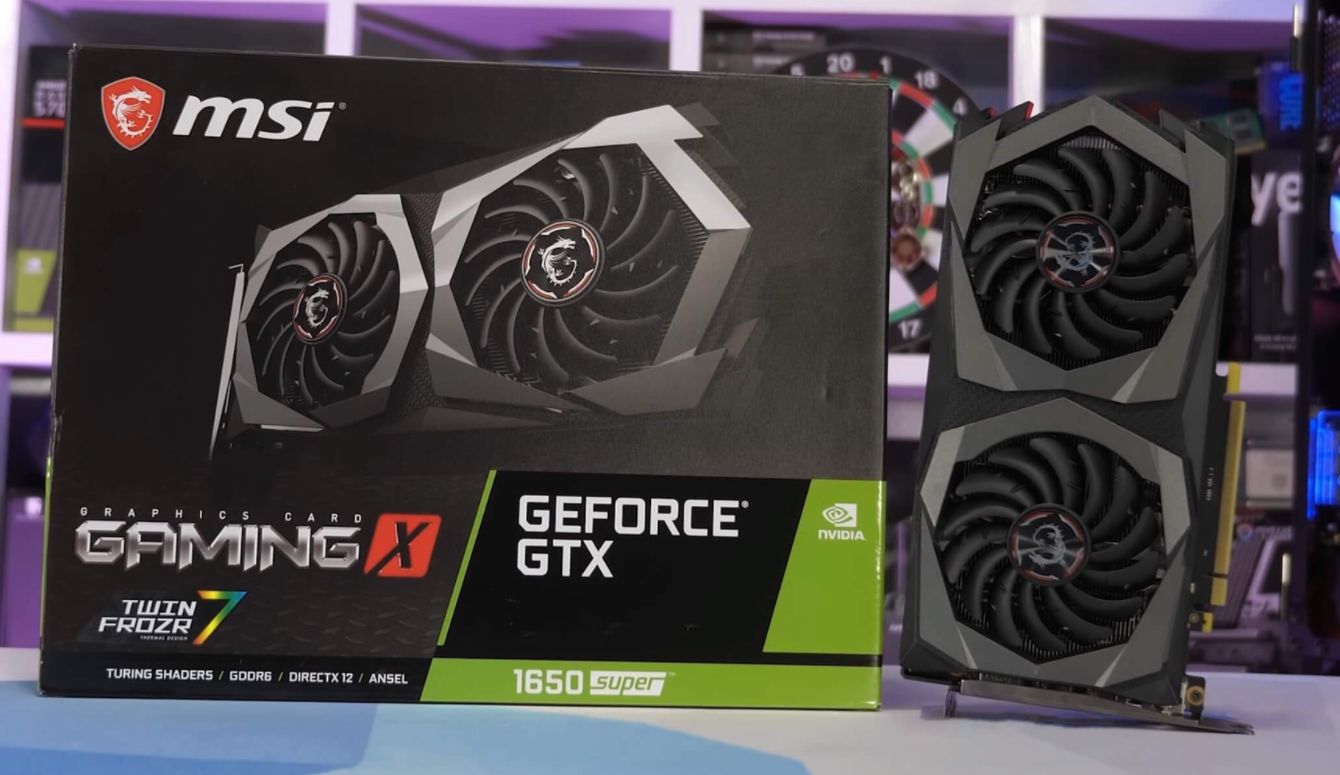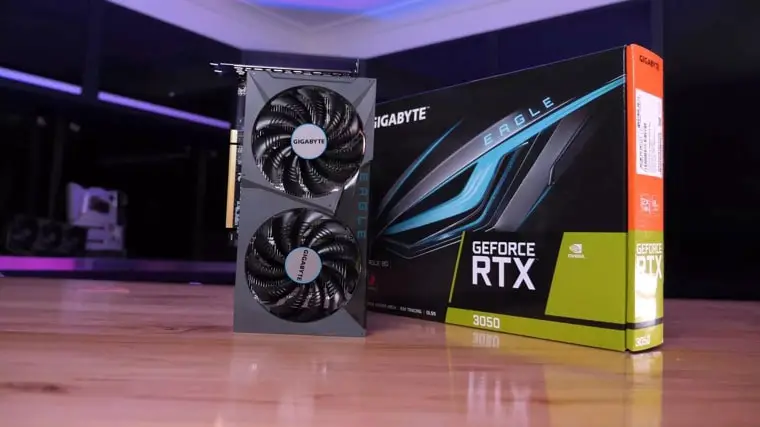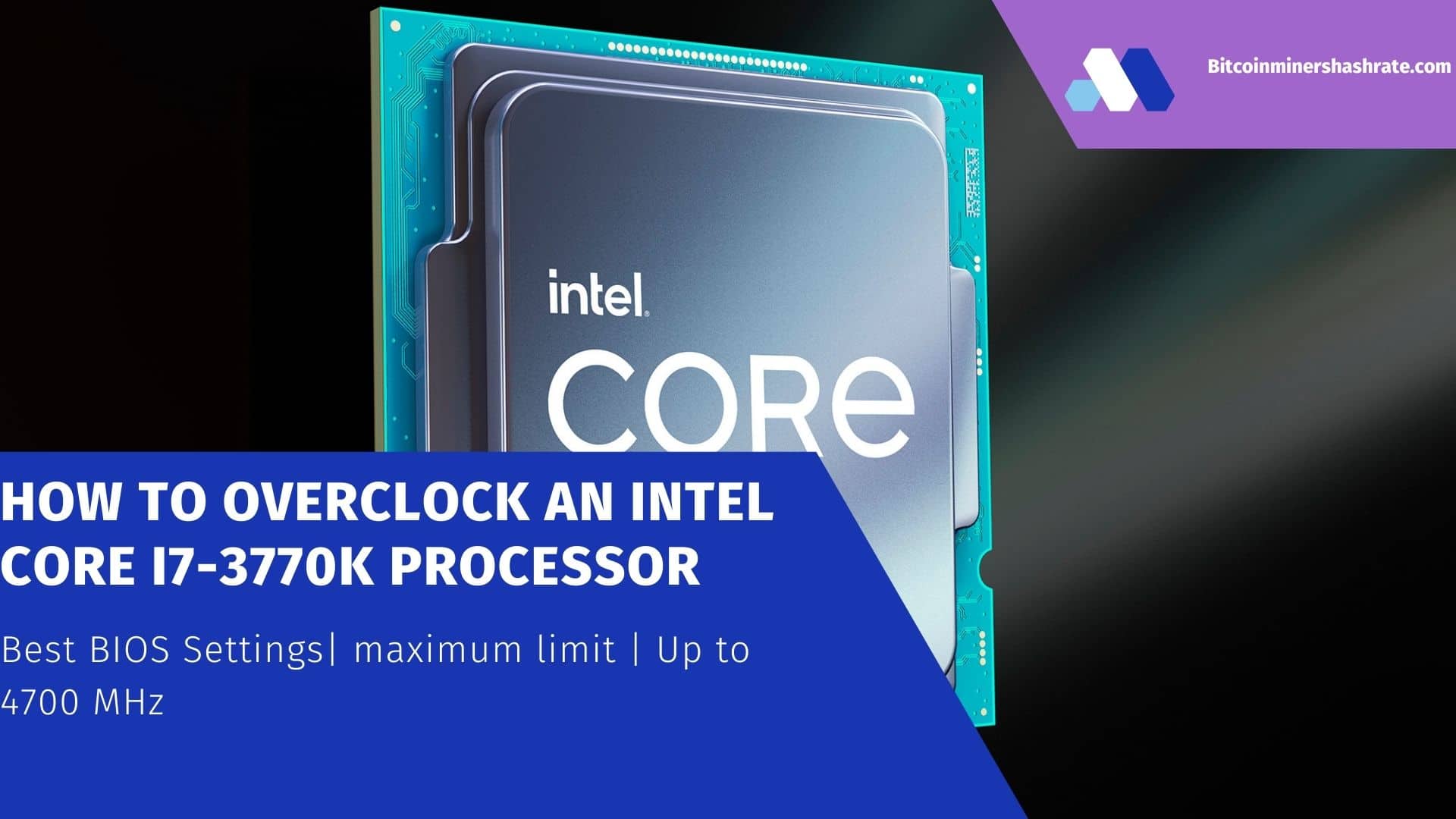How to ‘increase/ Max/ Optimize/ Boost‘ Asus GTX 780 Ti Gaming + Mining: Overclocking | Hashrate| limiter bypass | (Original BIOS) Power Limit/ Ethereum / GPU Booster 2.0.
It is finally available the most prestigious graphics car ultra high-end graphics cards and it is of course the Asus GTX 780 Ti DirectCU II.
We have been waiting for it for several weeks and we can finally discover its formidable capacities. More than a month has passed since the announcement of the benchmark model developed by Nvidia and the latter had been extremely convincing.
More powerful and faster than the famous Titan, the GTX 780 grabbed the top step of the podium while being more affordable.
How to Overclock A GPU For Mining CryptoCurrency in HIVEOS | Guide for New Crypto Miners
In today’s New Crypto Miner Guide we dive into “How to Overclock & UnderVolt your GPU in HIVEOS for Mining CryptoCurrency”. For this video we are using all AMD Cards for our Overclocking guide and tutorial. The goal of Overclocking and Undervolting is to get the MOST out of your GPUs at the lowest watts possible.
Maximixing your GPUs potiental at the least amount of electricity cost. Note: Everyones GPUs are different, what works for me won’t work for you and vice versa. Try my settings if you want but also tweak your own settings for what works for your unique cards.
The version specifically designed by Asus is called GTX 780 Ti DirectCU II and it embeds real innovations making it even more attractive compared to its rivals.
The GTX 780 Ti DirectCU II is coated with one of the best cooling systems on the market, the DirectCU II. The brand announcing it as twenty percent more efficient and above all three times quieter!
Accommodating ten DIGI + VRM Super Alloy Power phases, the most powerful graphics card will benefit from better efficiency, higher reliability and increased overclocking potential.
Moreover, the frequencies of the graphics processor have been revised upwards directly from the factory in order to offer players unparalleled playing comfort.
So will the Asus GTX 780 Ti DirectCU II be the best graphics card of this year just started?
Asus has three models among the GTX 780 Ti. The first takes up the reference design while the second is also signed DirectCU II.
If the GTX780TI-DC2-3GD5 keeps the frequencies recommended by Nvidia, our test card, the GTX780TI-DC2OC-3GD5 benefits among other things from a factory overclocking. The Nvidia GTX 780 Ti GPU aka the GK110 then goes to 1020MHZ against the 875MHz of the basic version.
This increase of sixteen percent is obviously accessible to many GTX 780 Ti but it will then be necessary to call on a specific application to benefit from this setting. The GTX 780 Ti DirectCU II keeps this profile by default and provides gains in the order of six percent.
DirectCU II is the essential cooling system for the brand’s high-end graphics cards. In the case of our test model, the brand guarantees twenty percent more efficiency on temperatures as well as up to three times less silence compared to the reference card.
In order to provide the graphics processor with the best possible power supply, the GTX 780 Ti DirectCU II embeds ten DIGI + VRM Alloy Power phases. This type of component is more efficient than traditional MOSFETs, provides longer card life, increased reliability, generates less loss and offers better overclocking capabilities.
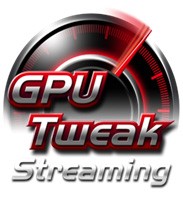
At the same time, Asus is developing a specific application essential to supervise the GTX 780 Ti DirectCU II: GPU Tweak.
This most complete software authorizes the functions related to overclocking either the modification of frequencies but also of the voltages or the speed of the fans.
The claims of the GTX 780 Ti DirectCU II are certainly most interesting. The manufacturer promises performance while maintaining exemplary operating silence, always thanks to its DirectCU II cooling system.
The GTX 780 Ti DirectCU II distinguishes itself primarily on the frequencies of the graphics processor. If the reference version is clocked at 875MHz, the GTX 780 Ti DirectCU II exceeds Gigahertz to reach 1020MHz.
Finally, note that the new Asus graphics card is aesthetically customizable thanks to a sheet of stickers.

The brand having opted for the color gold on a large number of motherboards dedicated to the latest fourth generation Intel “Haswell” processors, it is possible to switch it to red mode to suit more to ROG (Republic of Gamers) series cards.
As the Nvidia GK110 graphics processor has not fundamentally changed since the release of the GeForce GTX 780, we are therefore taking up the section concerning it by adapting it to the specificities of the GeForce GTX 780 Ti.
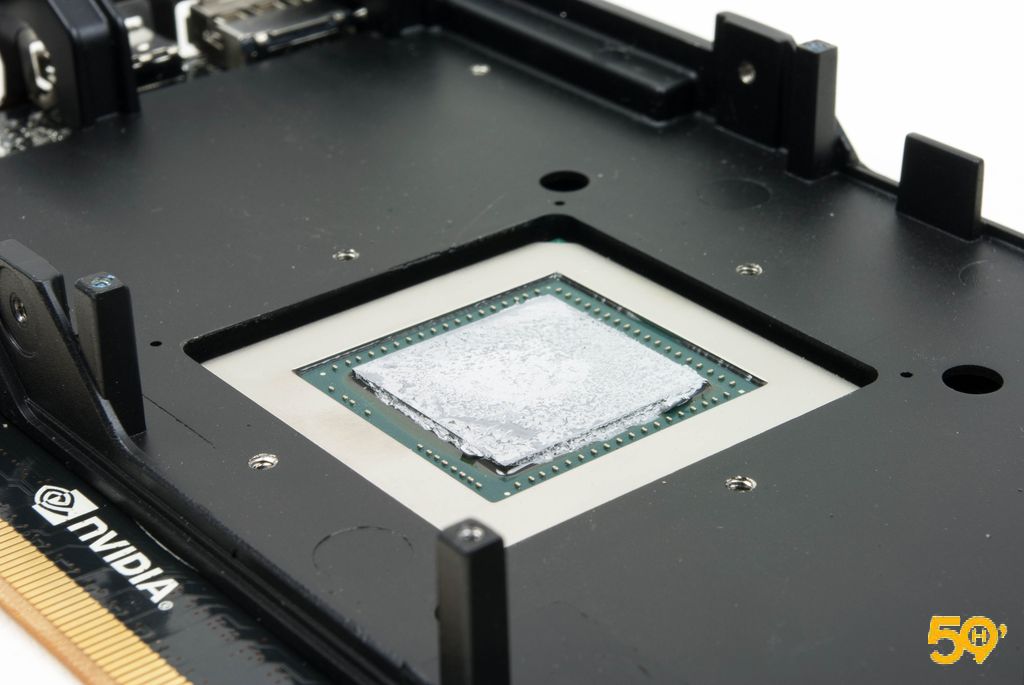
Nvidia’s GK 110 comes straight from the supercomputer industry. In fact, this chip was first introduced in cards called Tesla, the role of which is to offer very high performance on parallel computing tasks.
In the case of the GTX 780 Ti, we notice that the name is the same as that of the Titan, namely GK 110. We see that each revision can have a different reference. For example the GTX 780 had a GK 110 GPU on board and the GTX770 and GTX760 had a GK 104.
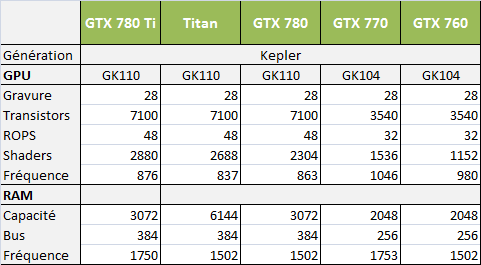
Let us take again the main characteristics of these chips belonging to the “Kepler” family, ie an engraving fineness of 28nm. It is also the same as that of the Radeon HD 7000, the first to have been able to benefit from it.
This nomenclature indicates that we keep an identical number of transistors, in the case of the GTX 780 Ti 7.1 billion. This is simply twice as much as in the GTX 680s.
The GTX 780 Ti also benefits from 48 ROPS while the GTX 680 embarked 32. The number of computing units reaches a total of 2880.
GPU frequency varies greatly with each card, but it no longer means that the highest will provide the best performance.
Thus the GTX 770 is capable of operating at 1046MHz, or it belongs to the “Performance” range of “gamers” cards. The GTX 780 Ti only needs a frequency of 876MHz to deliver phenomenal computing power.
Let’s also take a look at the onboard memory on the GTX 780 Ti which has 3GB of GDDR5 on board. This is half the size of the Titan, but you have to keep in mind that the capacity required depends only on the display resolution used.
For example, 2GB is sufficient for current games at resolutions up to 2560 × 1440 pixels. This is beyond that 3GB may be necessary and in particular by opting for a multi-screen configuration.
The 3GB will therefore be able to be used for future games and will allow the use of screens with ever higher resolutions. If the 2560 × 1440 will very quickly become democratized since they are now available from five hundred euros, the GTX 780 Ti is able to manage display formats of up to 3860 × 2160 pixels (Ultra HD).
In order to guarantee a fast texture processing capacity, the 3GB of the Nvidia GTX 780 graphics card is based on a 384-bit bus, another point in common with the GeForce Titan. And concerning its frequency, it increases compared to the Titan to reach 1750MHz.
GPU Boost 2.0

Appeared from the first GTX 680, GPU Boost in revision 1.0 revolutionized the operation of a graphics processor by automatically and transparently increasing the clock frequency.
For example, the GTX 680 benefited from a base frequency of 1006MHz but thanks to GPU Boost, it could reach 1059MHz. The number of images displayed per second in games increased, allowing the busiest scenes to keep optimal fluidity.
Like the GTX 780, the Ti version benefits from GPU Boost 2.0 bringing its share of improvements. In the first version, GPU Boost 1.0 controlled the GPU frequency only based on its TDP. However, if the temperatures reached values that were too high, the frequency dropped sharply to preserve the components.
With GPU Boost 2.0, the temperature is taken into account with increased precision, always to guarantee even higher frequencies but above all more stable.
The GTX 780 Ti will therefore be able to take advantage of its maximum speed known as Boost, provided it stays below 80 ° C. It’s a godsend because Nvidia’s new graphics card takes advantage of the Titan’s cooling system, which has nothing to envy to custom models from different manufacturers.
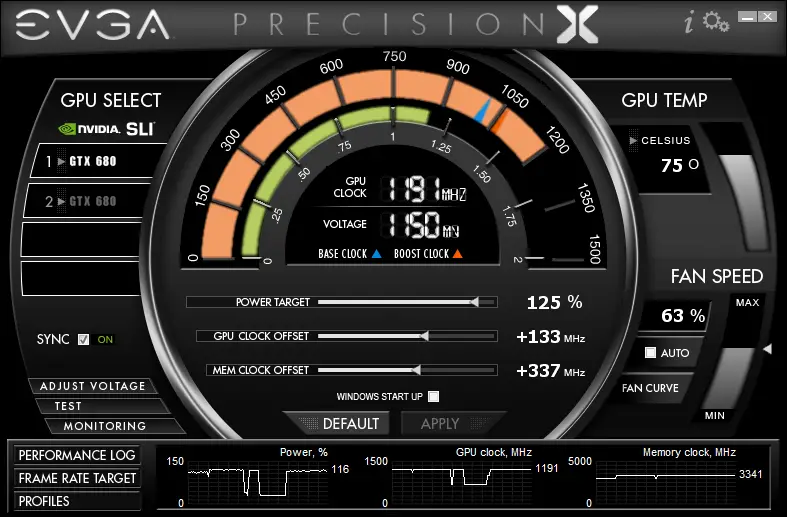
In practice, each brand offers software such as EVGA PrecisionX with its card. It will be enough to use it to control the temperature of the graphics processor so that it does not exceed 80 ° C.
In addition, these utilities for the best of them offer overclocking possibilities that will allow you to exceed the default threshold of GPU Boost 2.0.
Of course, if this kind of practice no longer represents a real danger for the components as it was the case many years ago, NVIDIA insists on the fact that intervening on the voltage can reduce the life of the card.
It is therefore understandable that the brand wants to compete in the market for factory overclocked cards which are very successful. However, the models offered by the firm are also perfectly suited to this type of exercise, so why go without?
PhysX
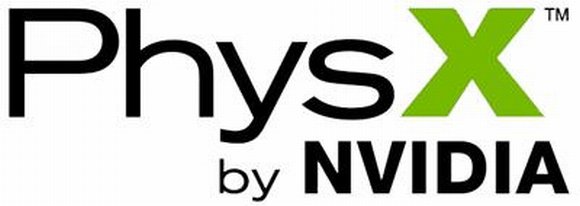
As we had already stated in our presentation, Nvidia works closely with the major game publishers so that the features embedded in its new cards are fully exploited.
PhysX continues to make real improvements contributing to the success of its cards. Moreover, its historical competitor AMD has not hesitated to follow suit by offering TressFX, a technology improving the rendering of certain elements of a game. The first to have been able to take advantage of it is none other than the last Tomb Raider in which the heroine’s hair is more realistic.
If this rendering technique remains available even with an Nvidia card, it requires heavy computing tasks that the vast majority of cards can handle.
Anti-Aliasing FXAA & TXAA
In addition to GPU Boost 2.0, the GTX 780 Ti supports FXAA, TXAA filtering techniques and Nvidia Adaptive Vertical Sync technology.
These characteristics already present in the GTX 600 generation offer the best anti-aliasing, that is to say that the contours that may appear on the screen in the form of stairs are smoothed to improve the overall quality of the display. . If the usual techniques also required a lot of resources in terms of calculation, FXAA and TXAA are optimized to save the available power without compromising on the quality of the final rendering.
Nvidia adaptive Vertical Sync

Nvidia adaptive Vertical Sync is the third feature offered by the GTX 780 Ti. It is also present on the GTX 680 and its role is to limit slowing down and the effects of “tearing”. This process is based on the vertical synchronization of the display to anticipate drops in framerate and eliminate artifacts that could appear during a game.
GeForce Experience
GeForce Experience remains Nvidia’s flagship application. It offers many tools facilitating and optimizing all the games on the PC.
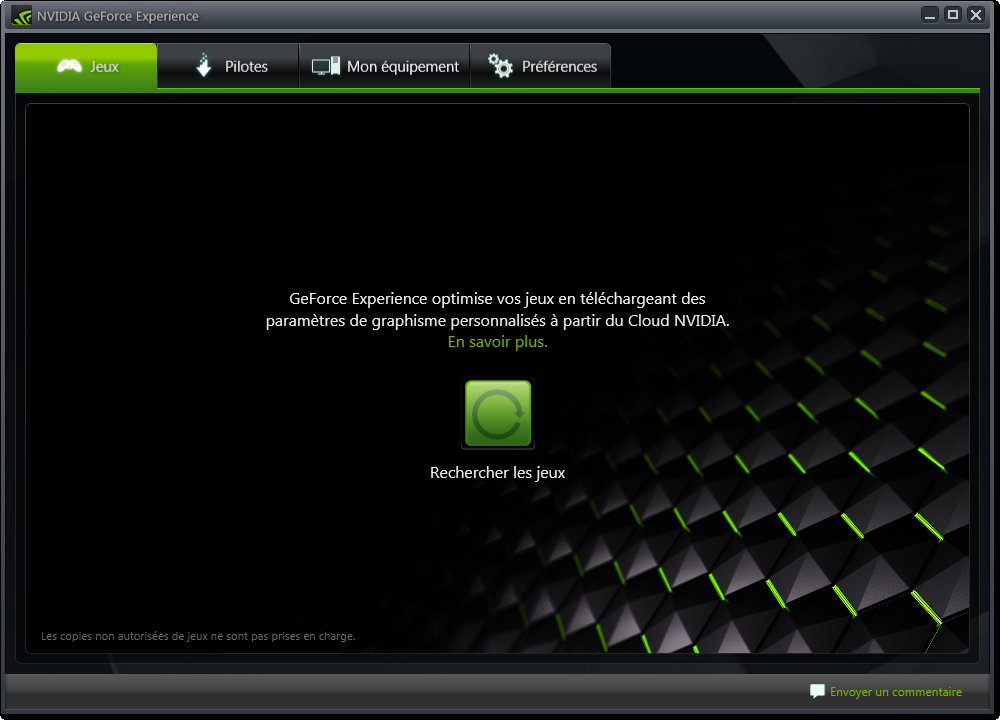
With the proliferation of display-related settings, it has become difficult to quickly and correctly configure our games. While consoles do not have this drawback, they are still limited by the hardware components of the equipment. Xbox 360 and PS3 are already several years old and only the PC is able to offer ever more immersive graphics.
Thanks to GeForce Experience, gamers combine the simplicity of configuring the console and the graphic quality of PCs.
In addition to automating the updating of graphics card drivers, GeForce Experience is in charge of constantly communicating with the Nvidia data centers on which all the game profiles are hosted.
These servers therefore contain all the information necessary to optimize each title. They will take care of defining the ideal configuration according to the desired framerate.
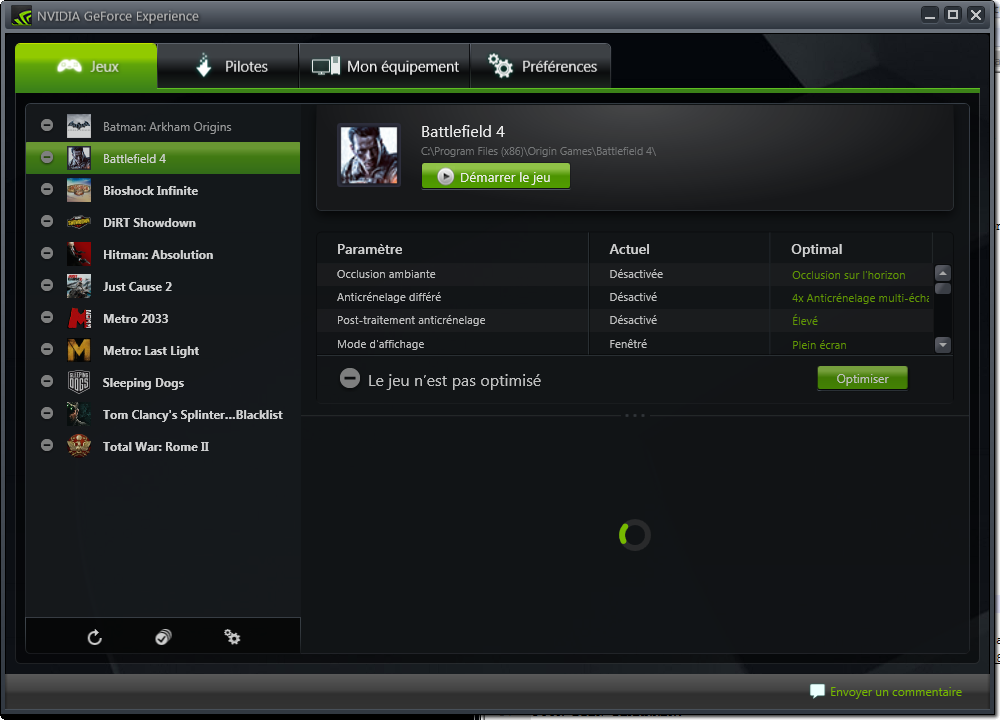
Once the application is installed, a wizard is responsible for detecting all the games installed on the machine and a single click on the “optimize” button will suffice to obtain the best possible combination of options.
GeForce Experience will quickly become essential since in the best case, the gains could exceed 50% of images per second.
ShadowPlay
ShadowPlay integrates with GeForce Experience. This tool accepts to record video of games parts. If specific software is able to perform this task, they are either paying or poor in functionality.
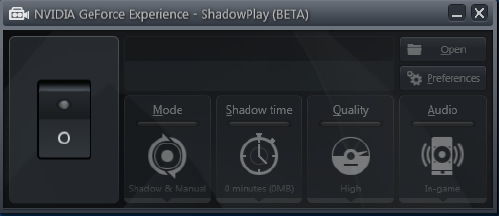
Thanks to the hardware H.264 encoder integrated in a large number of Nvidia graphics processors, the videos will be of excellent quality since they can reach the resolution of 1080p.
The use of the ShadowPlay interface is immediate because it consists of only four buttons.
The first “Mode” switches between Shadow mode and Manual Mode. The first is continuous while the second is activated according to the needs of the players.
The second button will determine the duration of the recording while the third is for the quality of the final video. The right compromise between file size and display quality is therefore easy.
Finally the last button concerns the audio that we can also record or ignore to possibly limit the size of the video.

One last option caught our attention because future NextGen consoles will also be affected. Thanks to ShadowPlay, it will be possible to stream the game video from the PC to the Nvidia Shield console live!
Going back a while, the Asus GTX 680 DirectCU II was streamlined like a real bunker. MSI’s Lightning models therefore tended to be favored by gamers.
With the custom GTX 780 Ti, the balance will very likely go in favor of Asus because the GTX 780 Ti DirectCU II frankly has all the assets to seduce.
The most imposing, the new Asus card has a devastating and aggressive look. Still based on a dominant black accented with gold-colored ornaments, the GTX 780 Ti DirectCU II still has a metal protective cover. Worked and refined, it reinforces the sporty impression of the menu.
At the rear of the GTX 780 Ti DirectCU II, we discover a reinforcing plate stiffening the card definitely heavy compared to competing models. It also plays a role in cooling components.
The unfortunately still silver facade proves that the brands are still not decided to paint it black while the vast majority of PC cases are painted.
However, there is now a very classic connection: two DVI video outputs, one HDMI and one last DisplayPort.
The GTX 780 Ti DirectCU II requires two eight-contact power connectors to ensure the most stable voltages and highest power.
Once the DirectCU II cooling system has been dismantled, we discover a PCB of exemplary quality. The concept remains usual. The graphics processor sits in the center of the card and is surrounded by memory chips.
The 3GB are grouped into twelve Hynix brand chips.
In the case of the GTX 780 Ti DirectCU II, the ten DIGI + VRM power stages are placed at the rear.
Finally at the end of the card, is placed the voltage regulator of the GPU.
The main role of the back plate is to stiffen the card given its significant weight. It is joined to a lateral reinforcement. Its second role is to improve heat dissipation thanks to the numerous performances present on the entire surface.
Also compared to the GTX 680 DirectCU II, the new GTX 780 version employs two different fans. If the one at the rear is more classic with straight blades very effective in injecting air deep through the many fins of the radiator, the second employs a much more refined design.
CoolTech technology allows the optimization of air flow over a larger area. This exclusive concept therefore significantly improves the efficiency of the cooling system as a whole but also makes it possible to limit noise pollution.
The Asus DirectCU II cooling system is the most successful in the field. Its quality of finish is spectacular and without the slightest defect.
The base is directly made up of heatpipes, while traditional cards are satisfied with a thick perforated plate through which the heat conductors pass.
The efficiency of DirectCU II will be all the more important in particular by the presence of a high-end radiator segmented into four sections. Each heatpipe therefore benefits from a clean surface for efficient cooling.
Once the cover has been unscrewed, we discover on the upper part of the DirectCU ii a compartmentalization of the two fans so that they provide the most important air flow while maintaining the lowest sound level.
The heatpipes are also oversized offering improved dissipation compared to competing cards.
Based on several stages, the radiator of the DirectCU II cooling system leaves no stone unturned for the best possible dissipation. This concept makes it possible to offer the largest volume of fins for a footprint not exceeding the two expansion slots.
Our card is installed on the following machine:
Hardware
Boitier : CM Striker
Alimentation : Enermax Platimax 1000W
Carte mère : Intel DX79SI
Processeur : Intel Core I7 3930K
Ventirad : Noctua NH-D14
RAM : 4 Go Gskill Ripjaw 1600Mhz CL9
Stockage: 1 SSD Crucial M4 256Go.
Software
Windows 7 X64 Home Premium Edition SP1
Latest Drivers
EVGA PrecisionX
GPU-Z
Benchmark
3Dmark 2011 from Futurmark available on www.futuremark.com
Unigine Heaven 4 available on www.unigine.com
Alien VS Predator
Metro 2033
Sniper Elite V2
Hard Reset
During our tests, we carried out three measurements at three different resolutions:
1280×1024 pixels
1680×1050 pixels
1920×1080 pixels
For each of these resolutions, we also performed three separate tests:
Low
graphics
quality Average graphics quality High graphics quality
Regarding the low quality, we have systematically deactivated all the available options. Both anti aliasing and tessellation are configured to a minimum or even disabled. Texture details and other possible filters have also been disabled.
In medium quality, we set the anti aliasing to 4X, and the texture filtering in general to 8. We did the same for tessellation.
Finally in high quality, we have pushed all the options to the maximum.
3DMark

Futuremark, the famous editor of the benchmark dedicated to graphics cards: 3DMark 2011 offers a new version including three series of tests: Ice Storm, Cloud Gate and Fire Strike.
Cloud Gate is designed for “performance” platforms with an emphasis on Post Processing and Particle Effects. A second sequence is aimed at volumetric lighting but using a low level of geometry.
Cloud Gate’s third test simulates the physical effects on rigid and deformable objects.
3DMark by Futuremark is available at www.futuremark.com
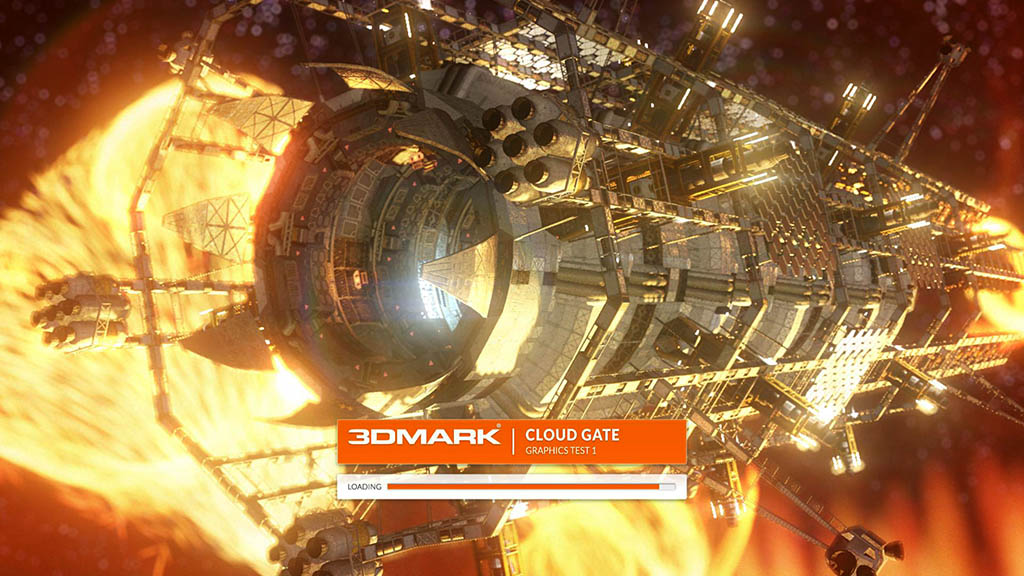
We use the settings offered by default.
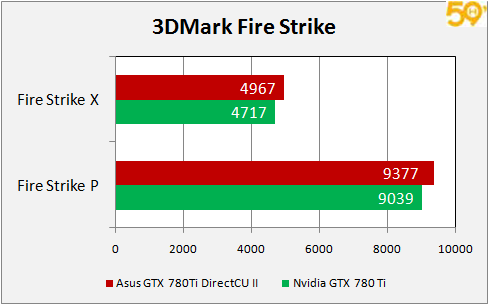
The tests got off to a strong start with 3DMark, which was close to 5,000 points in extreme mode and 10,000 in performance mode.
Unigine Heaven 4.0

Unigine Heaven is our synthetic test of choice because, in our opinion, it is the most representative benchmark of video games by best reflecting their performance.
Unigine Heaven is available on the publisher’s website: www.unigine.com

We configure Unigine Heaven in DirectX 11 API and during our measurement in low level of detail mode, we set the shaders to “low”, the tesselation is to “disabled”, the anisotropy is to 1 and the anti aliasing is on “Off”.
In medium level of detail, the shaders are in “medium”, the tessellation in “normal”, anisotropy at 8 and anti-aliasing at 4.
Finally in high mode, the shaders are in “high”, the tessellation in “extreme”, the anisotropy at 16 and finally the anti aliasing is in 8x.
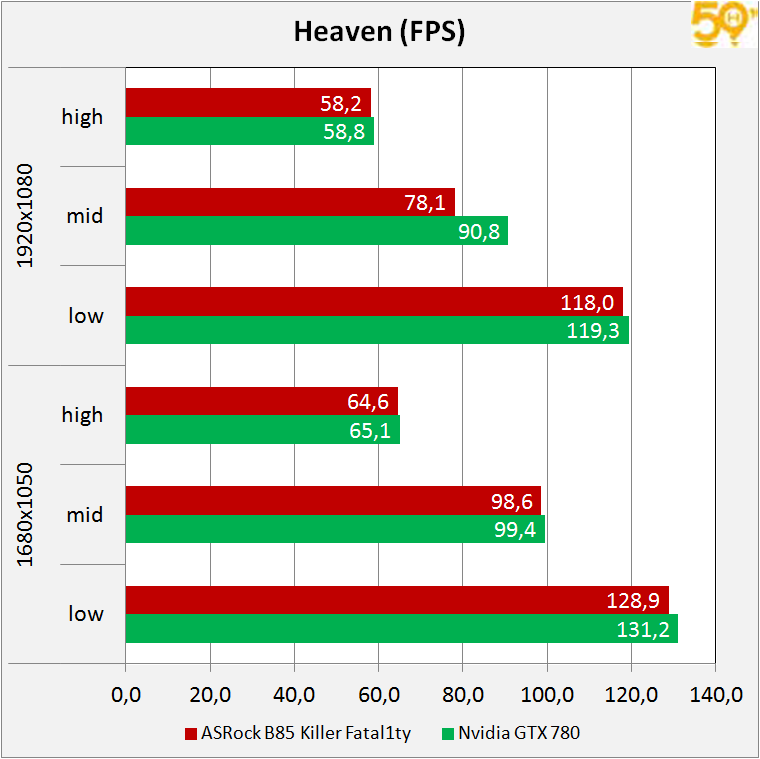
The differences with the reference card remain low, however, the Asus GTX 680 DirectCU II is the fastest.
Unigine Valley 1.0
Unigine also offers another benchmark: Valley 1.0 which has the particularity of reproducing very complex natural elements in terms of calculation.

Unigine Valley 1.0 is available on the publisher’s website: www.unigine.com
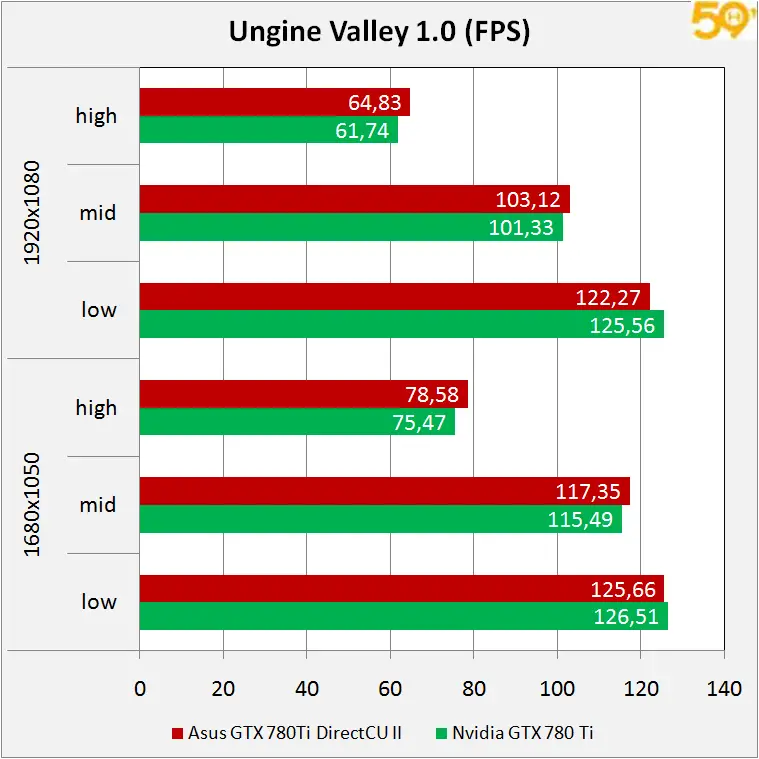
Just like under Heaven, the framerates indicate that the Asus GTX 680 DirectCU II will run all games, including the most demanding.
We are also interested in Hard Reset known for its favor towards chips produced by Nvidia. We include it in our tests since it has the particularity of being optimized on the computing power required for anti aliasing and tessellation.
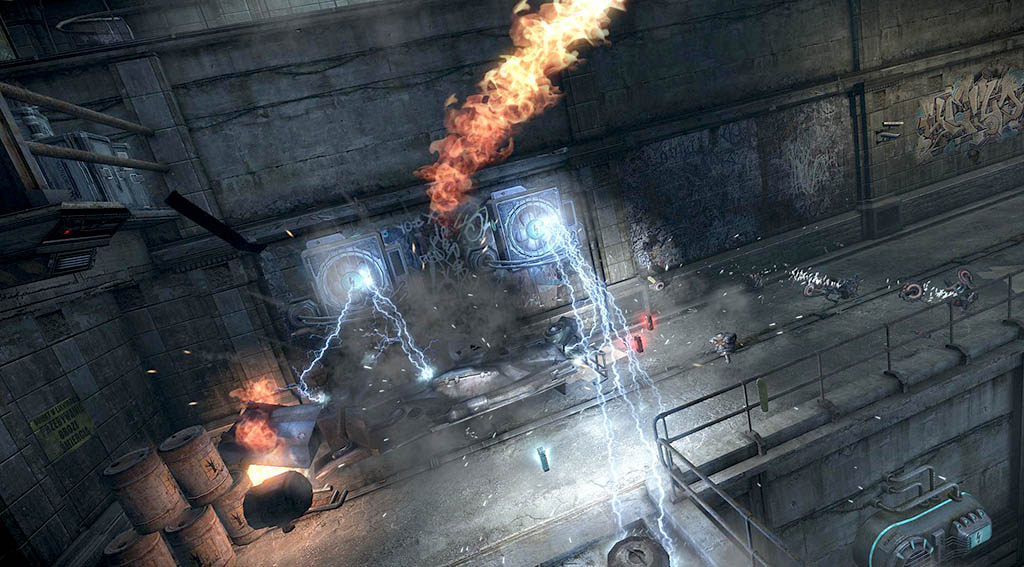
For each of our three resolutions used, we find our now classic levels of detail: low, intermediate and high.
Regarding this title, we deactivate the anti aliasing like the tessellation in low mode, we configure the anti aliasing in x4 and the tessellation in normal for the intermediate mode and finally, we push all the options to their maximum for the most test. requiring.

The scores leave you dreaming also under Hard Reset with 120FPS in extreme mode. A performance that only the GTX 780 Ti can offer.
When it was released, Metro 2033 put many graphics cards on its knees, in particular due to effects requiring significant computing resources. We use the DirectX 11 API to take advantage of the latest innovations in visual effects.
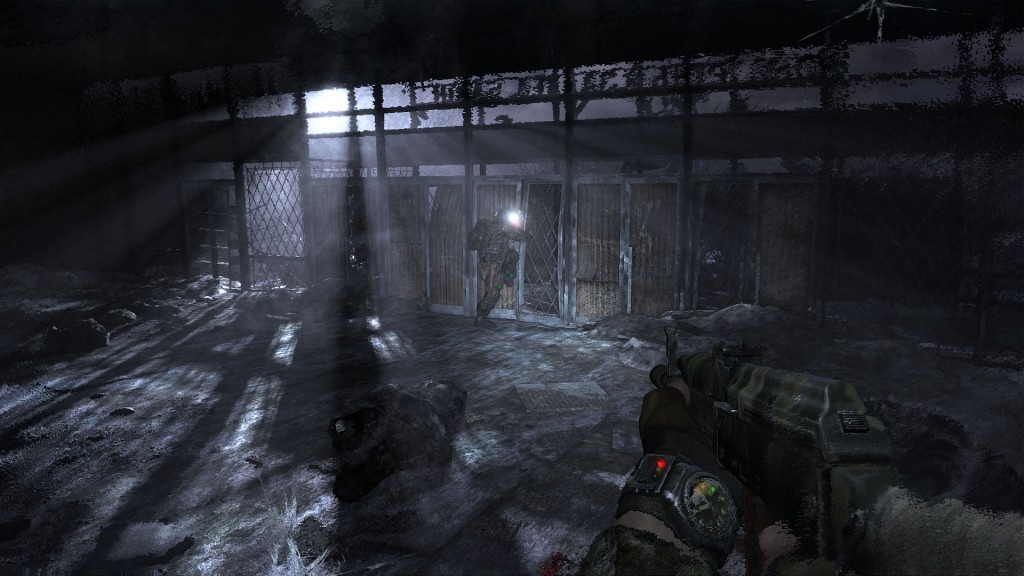
For each of the resolutions used, we always use three distinct levels of detail:
Low level: quality on “Low”, anti aliasing on “NOAA” and texture filtering at 4.
Intermediate level: quality on “Medium”, anti aliasing on “AAX4” and texture filtering on 4.
High level: quality on ” Very High ”, anti aliasing in“ AAX8 ”and texture filtering on 16.

Metro 2033 was previously a torture for graphics cards, and Asus’ GTX 780 Ti is so powerful it offers unparalleled gaming comfort in Metro 2033.
Now we get to the heart of the matter as we move on to gaming metrics with Alien vs Predator which offers an excellent overview of moderately demanding games.

Our benchmark series starts with a resolution of 1280 × 1024, then 1680 × 1050 and finally 1920 × 1080 pixels.
For each resolution, we use three types of settings:
Low level: Anti aliasing in x1, low level of detail, texture quality at 0, shadow quality at 0 and anisotropic at 0. Ambient occlusions such as tessellation and Advanced Shadow Sampling are disabled.
Medium level: Anti aliasing in 2, medium level of detail, texture quality at 1, shadow quality at 2 and anisotropic at 8. Tesselation, shadow sampling and occlusions are always disabled.
High level: all the options are at the maximum and activated either anti aliasing in x4, high level of details, texture quality at 3, shadow quality at 3, anisotropic at x16 and the last three options activated.
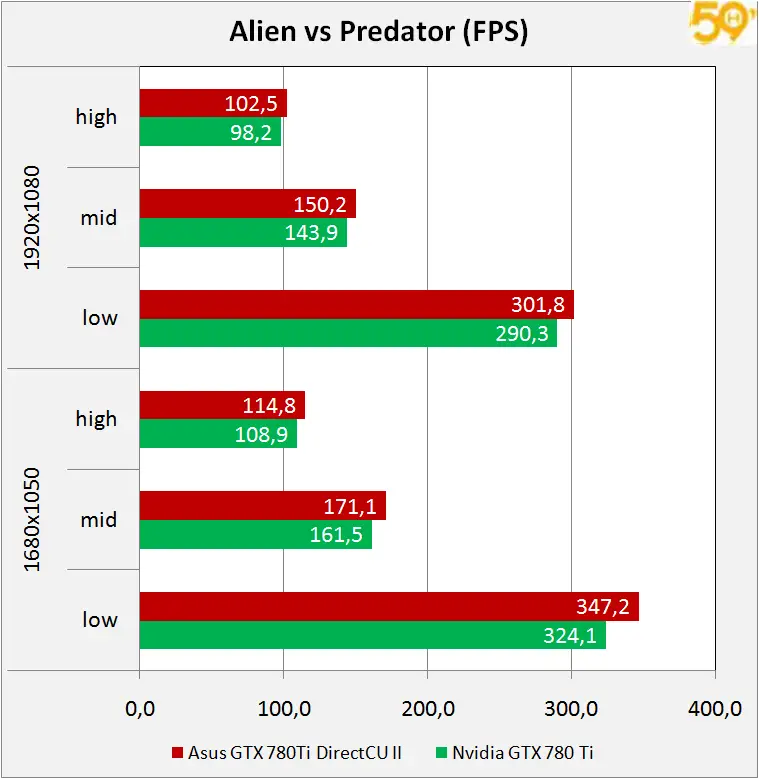
For the first time we exceed 100FPS in extreme mode at base frequency thanks to the Asus GTX 680 DirectCU II.
Very recently we have been testing the cards with Sniper Elite V2 because it is very demanding in terms of computing resources.
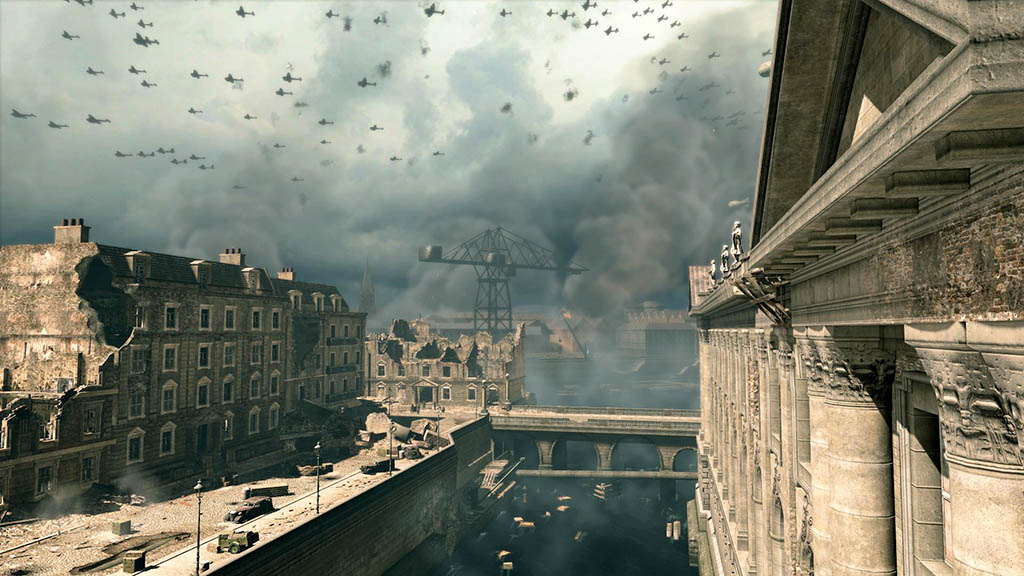
For each of our three resolutions used, we find our now classic levels of detail: low, intermediate and high.
Regarding this title, we deactivate the anti aliasing like the tessellation in low mode, we configure the anti aliasing in x4 and the tessellation in normal for the intermediate mode and finally, we push all the options to their maximum for the most test. requiring.
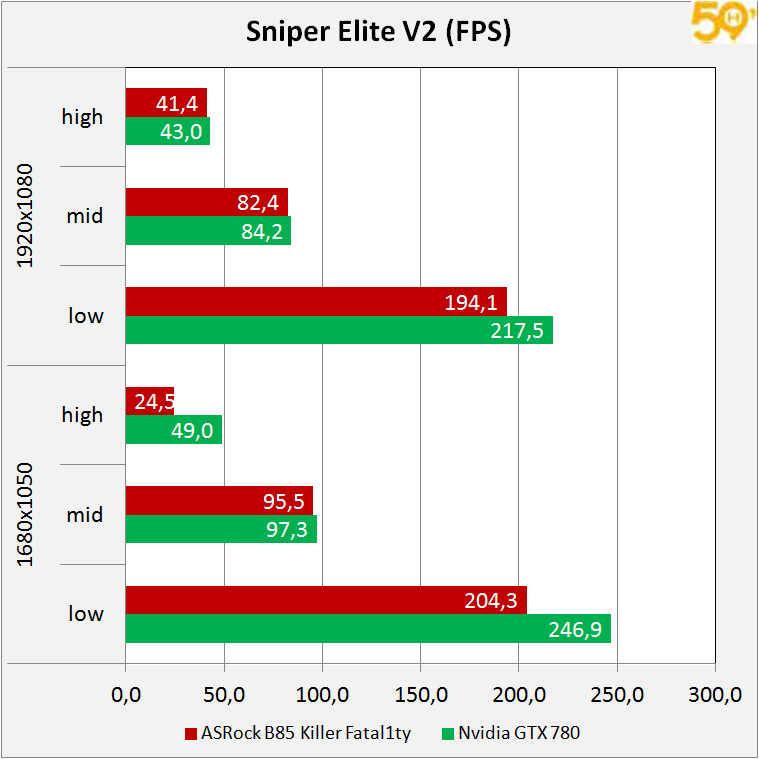
Small temporary weakness for the Asus GTX 680 DirectCU II which does less well than the reference card in high and extreme mode. The performances remain largely at the rendezvous.
Tomb raider 2013 has long been awaited to finally be able to take advantage of the latest technologies in 3D rendering. It includes an exclusive feature “Tress FX” dedicated to modeling the hair of the heroine Lara Croft.

In low quality level, all parameters are disabled or minimized.
In intermediate level, the texture quality level is 2, Tress Fx is disabled, anti aliasing is set to 2, shadows are set to 1 and reflections are also set to 1. Tessellation is disabled.
In high level, all options are at their maximum and activated.

It’s not TressFX that will hurt Asus’ GTX 780 Ti which displays 93FPS in extreme mode.
Sleeping Dogs is also a recent game and very demanding in computing resources. Its good design allows it to fit into our test bench.
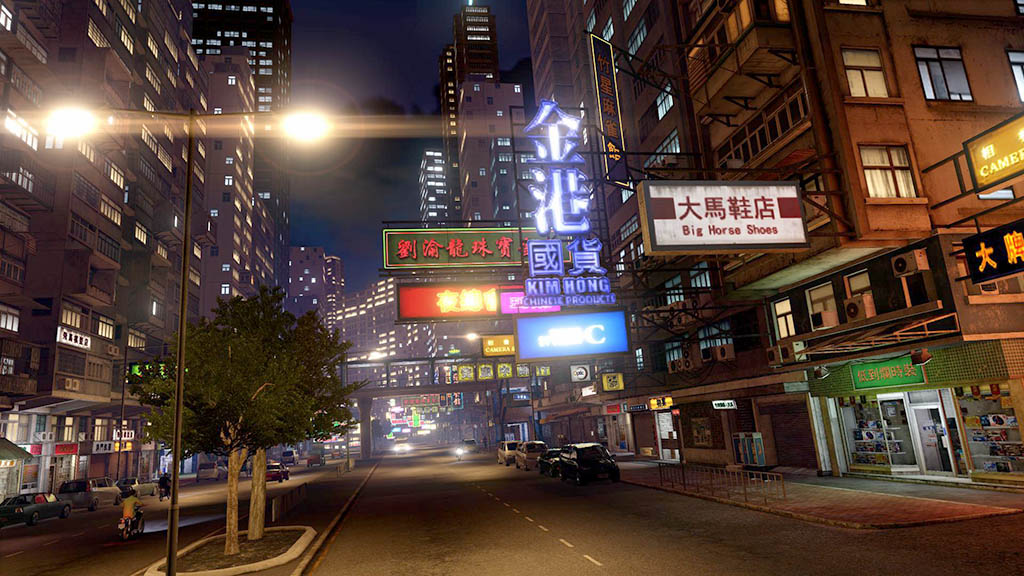
As with all the other titles tested, the minimum level is set in such a way as to favor performance at the retail level. Therefore, all options are disabled or set to minimum.
In intermediate level, we use the “High” mode and finally in maximum quality, we use the “Ultra” mode.
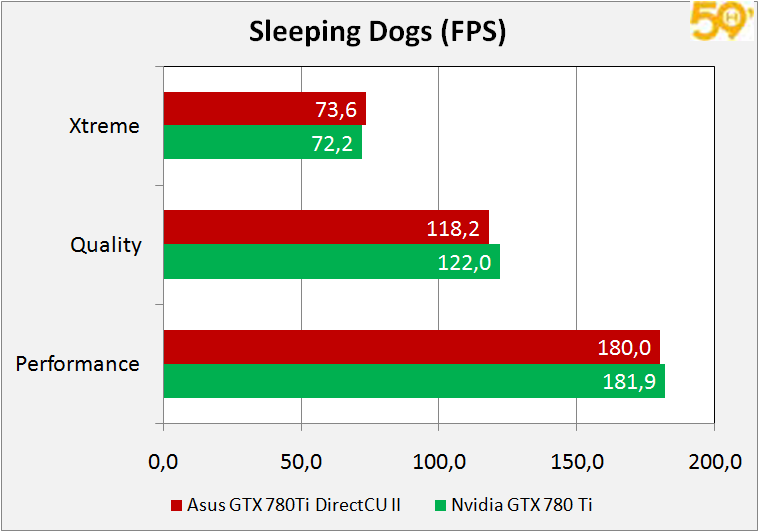
Under Sleeping Dogs, the difference is insignificant and for good reason the Asus GTX 680 DirectCU II is so powerful that it is in no way limited by this title.
Bioshock Infinite is the third installment of a saga that has enjoyed real success with the gaming community.

The latter is based on two resolutions: 1680 × 1050 and 1920 × 1080.
The minimum level is set to favor performance at the detail level. Therefore, all options are disabled or set to minimum.
In intermediate level, we use the “High” mode and finally in maximum quality, we use the “Ultra” mode.
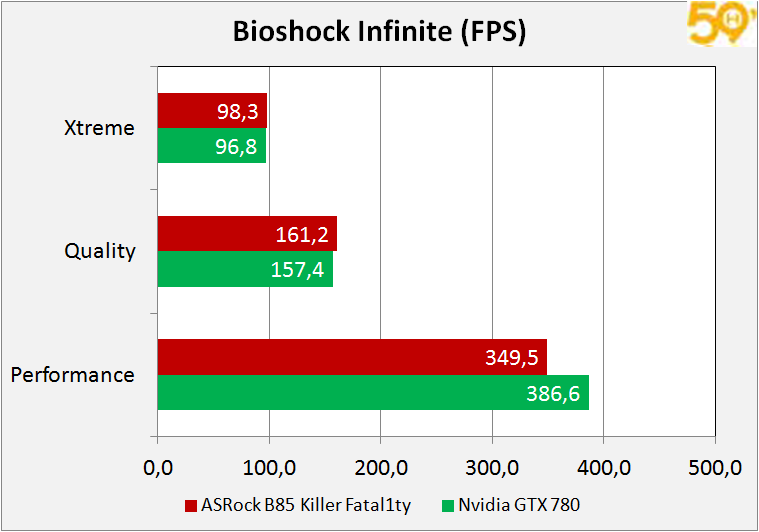
Under Bioshock, once again the GTX 780 Ti still keeps a serious lead over any card on the market.
Metro Last Light is also a recent game and very demanding in computing resources. It is of course the continuation of Metro 2033 also in our selection. Its good design allows it to fit into our test bench.

As with all the other titles tested, the minimum level is set in such a way as to favor performance at the retail level. Therefore, all options are disabled or set to minimum.
In intermediate level, we use the “High” mode and finally in maximum quality, we use the “Ultra” mode.
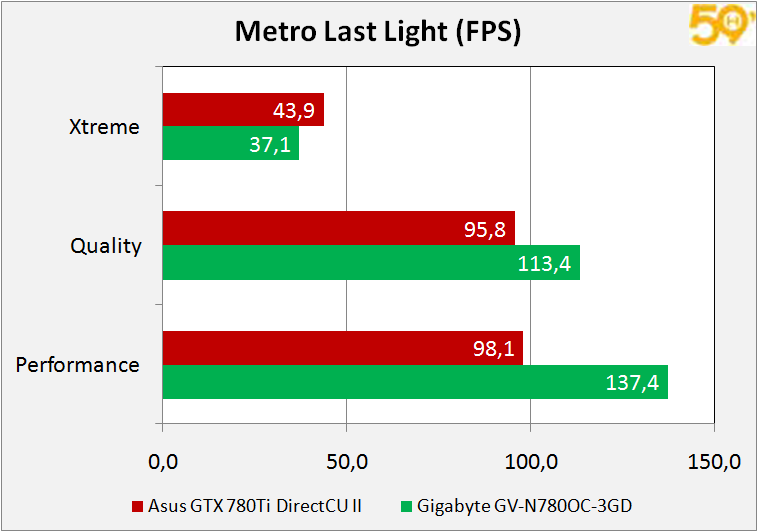 It is in the most demanding titles that the Asus GTX 680 DirectCU II takes on its full meaning by offering impressive framerates.
It is in the most demanding titles that the Asus GTX 680 DirectCU II takes on its full meaning by offering impressive framerates.
Finally, we can integrate a reliable and representative benchmark into our tests: Hitman Absolution.
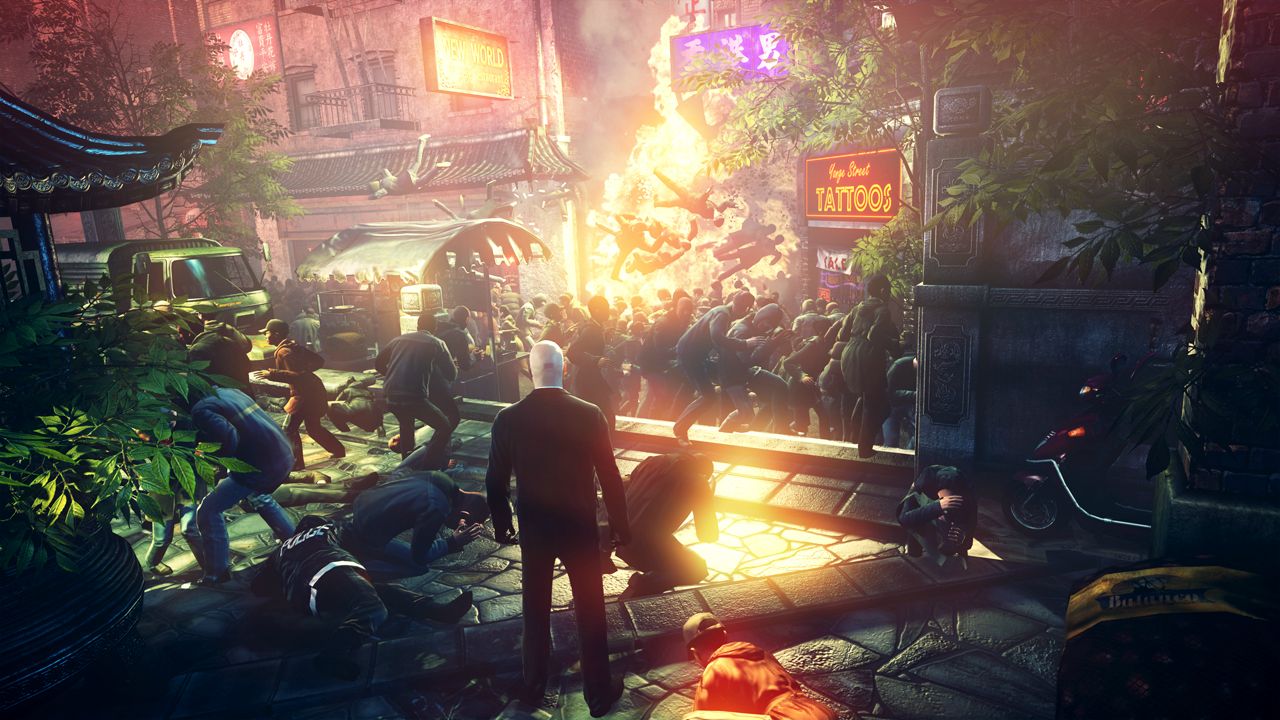
The minimum level is set to favor performance at the detail level. Therefore, all options are disabled or set to minimum.
In intermediate level, we use the “High” mode and finally in maximum quality, we use the “Ultra” mode.
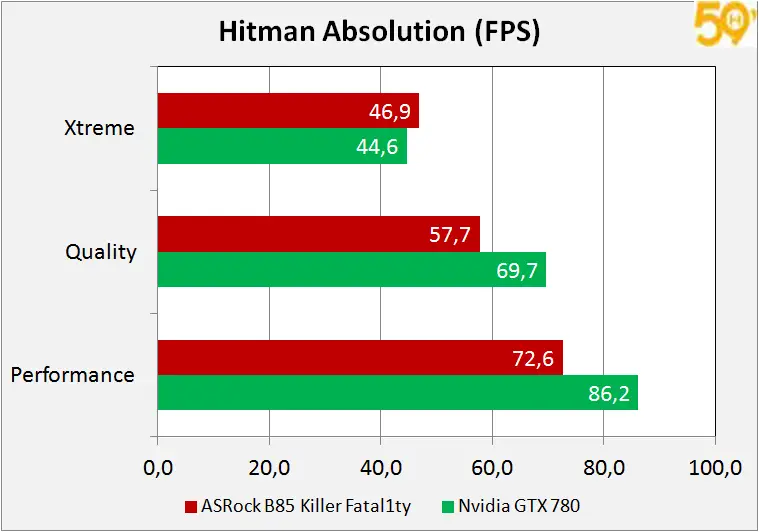
Hitman Absolution will be the only title optimized for AMD and yet the Asus GTX 680 DirectCU II provides an exceptional level of performance.
We selected Total War Rome II for its technical specificities in terms of graphics requiring a powerful graphics card to operate.

As with all the other titles tested, the minimum level is set in such a way as to favor performance at the retail level. Therefore, all options are disabled or set to minimum.
In intermediate level, we use the “High” mode and finally in maximum quality, we use the “Ultra” mode.
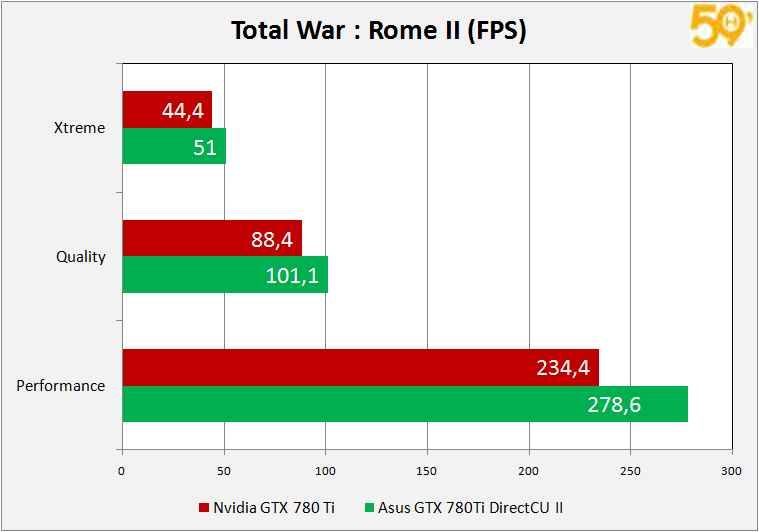
One last time, the reference card takes the advantage, but the Asus GTX 680 DirectCU II offers ideal playing comfort.
Batman Arkham Origins is essential because it is particularly optimized for Nvidia graphics cards including the GTX 780Ti.
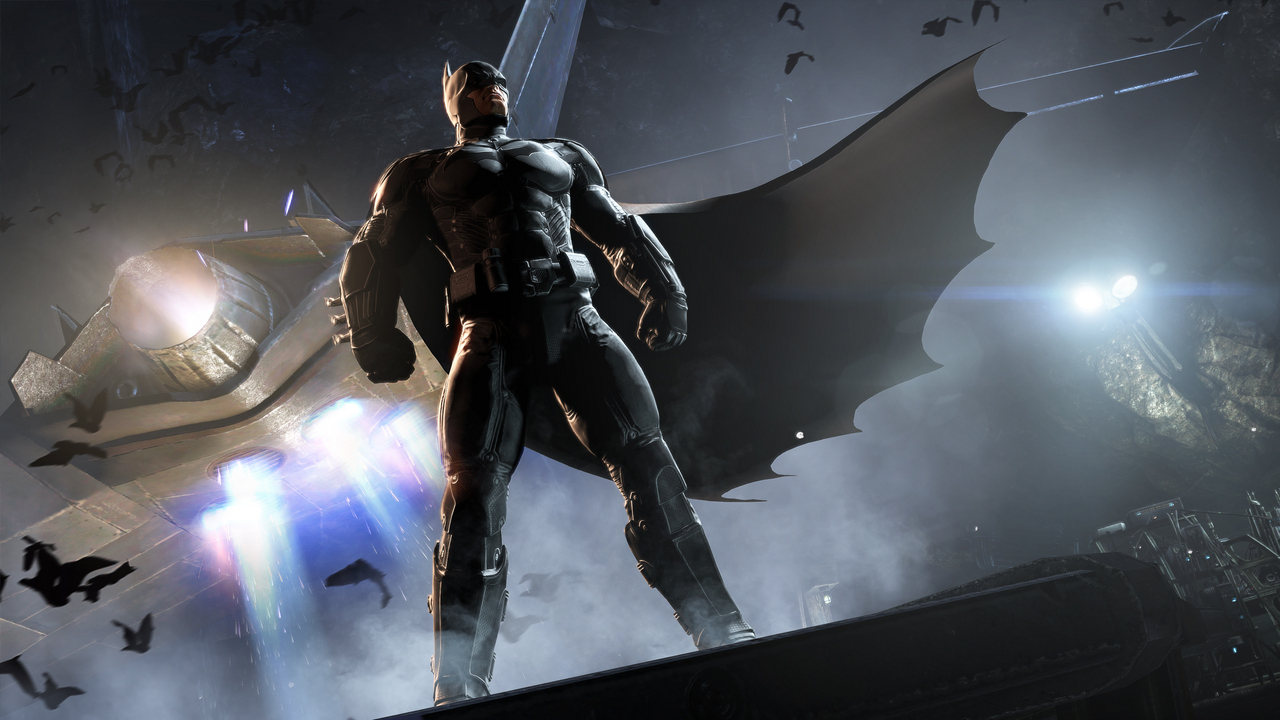
As with all the other titles tested, the minimum level is set in such a way as to favor performance at the retail level. Therefore, all options are disabled or set to minimum.
In intermediate level, we use the “High” mode and finally in maximum quality, we use the “Ultra” mode.
Small specificity of this test, we activate Nvidia PhysX only in Ultra mode.

The two cards are neck and neck with over 60FPS in extreme mode.
Unfortunately, overclocking a graphics card does not increase performance as much as the processors of our PCs. If for the latter the gains can be substantial and in many cases gain fifty percent of performance easily, GPUs rarely exceed ten percent.
In order to reach the maximum frequency of the card, we first increase the speed of the GPU and when we have reached its limit, we do the same with the memory. Once we have validated their optimal frequencies, we combine the two GPU and RAM values in order to ensure stability with a test under Bioshock then another with Tomb Raider and Hitman to see the gains obtained.
The cooling system is not modified and the fan speed remains set in automatic mode. We also take care not to exceed a temperature that is too high and therefore dangerous for the life of the components.

The overclocking capabilities of the Asus GTX 780 Ti DirectCU II OC are interesting because we were able to increase the GPU frequency by 200MHz and the memory by 100MHz.
The card therefore works at 954MHz theoretically and its GPU Boost allows it to provide 1020MHz. But in practice, the Asus GTX 680 DirectCU II operates at 1084MHz in stock, i.e. 64MHz more.
In overclocking, we configure the 1154MHz card but in reality, the Asus GTX 780 Ti DirectCU II OC goes up to 1255MHz.
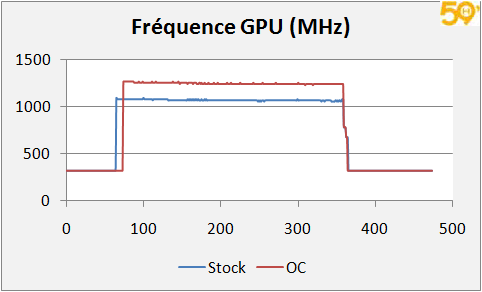
The GPU frequencies are perfectly stable including manual overclocking, proof that the Asus GTX 780 Ti DirectCU II OC is perfectly cooled.
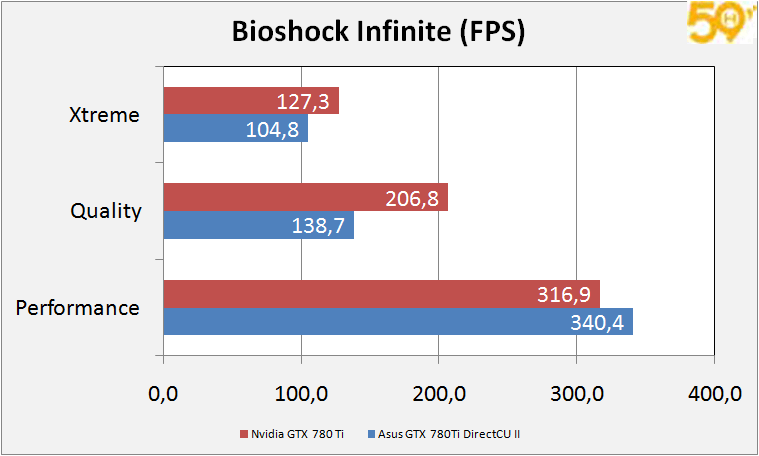
Under Bioshock the gains are impressive with more than 20FPS of difference in extreme mode.
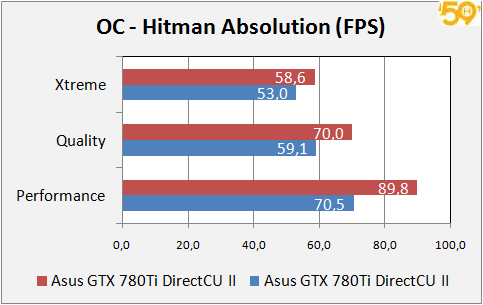
Hitman much heavier in computing power gets a gain of 5FPS with the Asus GTX 780 Ti DirectCU II OC in extreme mode.
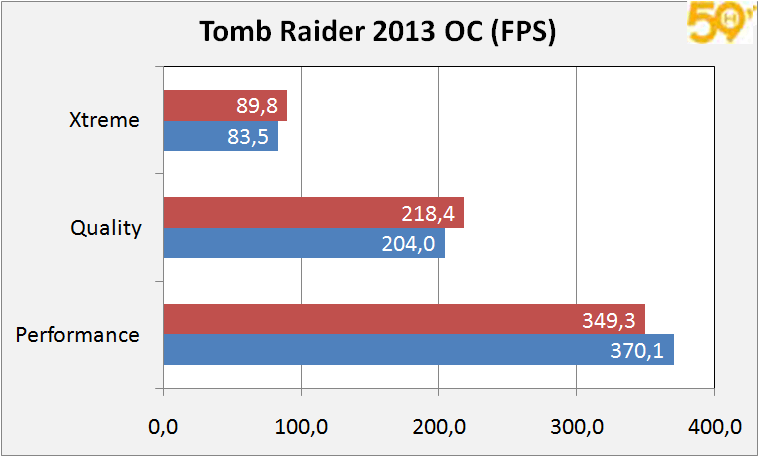
Finally Tomb raider also gains around 5FPS in extreme mode.
The temperatures of the Asus GTX 780 DirectCU II are recorded during a measurement of 8mins. It is useless to solicit the card any longer because beyond that the values are stable.
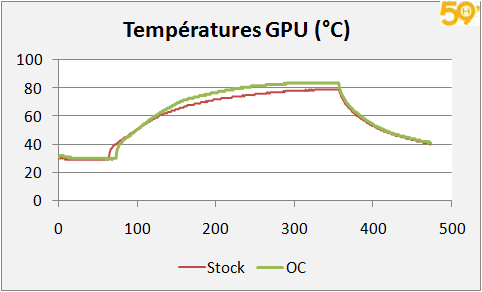
The GPU does not exceed 80 ° C at base frequency and barely exceeds them when overclocked.
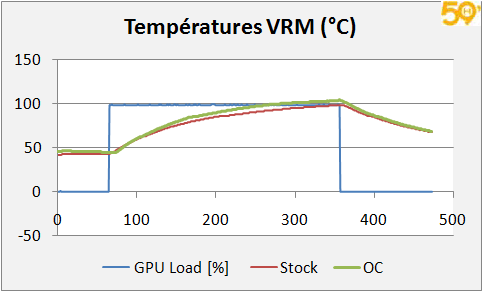
As a probe is present at the VRMs, we can now read their temperature. They reach 100 ° C overclocked or not.
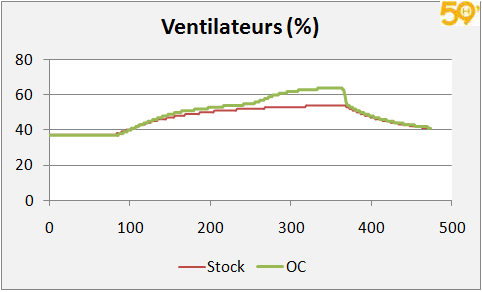
While the fans run at 50% base frequency, they drop to 60% once the Asus GTX 780 DirectCU II is overclocked.
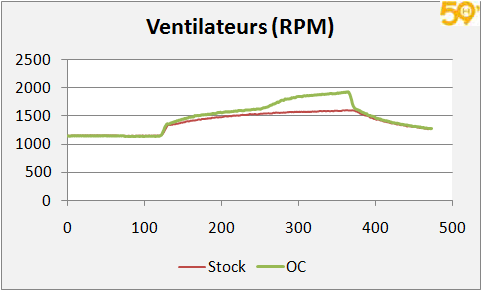
In terms of spin, the Asus GTX 780 DirectCU II is content with just 1600RPM at base frequency and doesn’t even need to hit 2000RPM in overclocking mode.
The TDP of the graphics card gives precise information relating to consumption and thermal release.
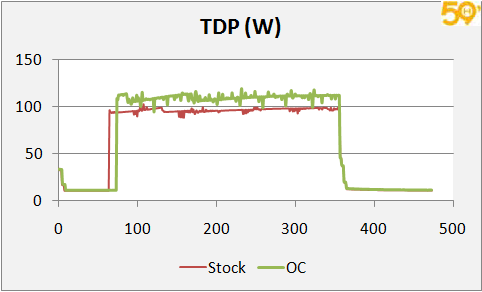
It indicates that the Asus GTX 780 DirectCU II fully exploits its potential by staying very close to 100% and slightly exceeds them once the card is overclocked.
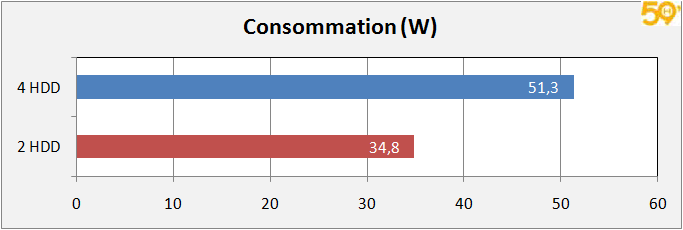
The electrical consumption of the Asus GTX 780 DirectCU II is perfectly contained because it barely exceeds 300watts at base frequency and it remains above 350W once overclocked. These values include the entire platform.

In terms of noise pollution, the Asus GTX 780 DirectCU II is king because it never reaches 39dB in game use, which makes it barely audible.
We were familiar with the Asus GTX 780 DirectCU II card having largely convinced us thanks to its many advantages and the GTX 780 Ti DirectCU II is even more exciting.
Aesthetically this new graphics card presented by Asus does not lack cachet. The possibility of changing from gold to red is an excellent idea for a perfect integration within the machine.
The quality of finish is absolutely remarkable and exemplary. No fault was found and the GTX 780 Ti DirectCU II remains a real benchmark in the field.
In addition, it offers a phenomenal level of performance capable of meeting absolutely all the needs of the most relentless players as well as those of ultra demanding users.

And for good reason, to date the GTX 780 Ti DirectCU II is the fastest graphics card on the market and no game will resist it even in the highest display resolutions with a maximum level of detail.
In addition to offering unparalleled computing power, the GTX 780 Ti DirectCU II benefits from an absolutely perfect cooling system in all respects. Our temperature measurements are clear, the GTX 780 Ti does not exceed 70 ° C while maintaining an almost inaudible operating silence!
Obviously perfection at a price that could possibly seem high: Seven hundred euros. But compared to the Geforce Titan still priced at over a thousand euros, the GTX 780 Ti DirectCU II remains the best possible choice to date for anyone wanting the fastest, most powerful graphics card.
| The + | |
| Most powerful graphics card ever tested! Cooling system as convincing as ever. Performance, functionality, unbeatable price ratio. |
Nvidia GeForce GTX 780 Ti – performance results in games and benchmarks
Interesting performance results of the new accelerator have leaked into the network.
In a few days, the Nvidia GeForce GTX 780 Ti graphics card will debut, which is to take the position of the most efficient 1-processor design on the market. One of the users of the Chinese forum ChipHell posted her unofficial performance results in games and benchmarks.
The GeForce GTX 780 Ti is equipped with a Kepler GK110 graphics processor with 2880 CUDA cores, 240 texture units and 48 rasterization units, as well as 3 GB of GDDR5 memory with a 384-bit interface. The standard clock speeds of the card are 876 MHz (928 MHz in Boost 2.0 mode) for the graphics processor and 7000 MHz for the memory.
Graphics card testing was conducted on a platform consisting of the following components: Intel Core i7 4960X processor overclocked to 4.5 GHz, ASUS Rampage IV Black Edition motherboard, 4x 4 GB of Corsair Dominator Platinum 2933 MHz and two Plextor M8P 512 GB drives connected to RAID 0.
| Model | GeForce GTX 690 | GeForce GTX 780 | GeForce GTX Titan | GeForce GTX 780 Ti |
| Graphic layout | 2x Kepler GK104 | Kepler GK110 | Kepler GK110 | Kepler GK110 |
| CUDA cores | 2x 1536 | 2304 | 2688 | 2880 |
| TMUs | 2x 128 | 192 | 224 | 240 |
| ROP units | 2x 32 | 48 | 48 | 48 |
| GPU clocking | 915/1019 MHz | 863/900 MHz | 837/876 MHz | 876/928 MHz |
| Video memory | 2x 2 GB GDDR5 256-bit | 3 GB GDDR5 384-bit | 6 GB GDDR5 384-bit | 3 GB GDDR5 384-bit |
| Memory clock | 6008 MHz | 6008 MHz | 6008 MHz | 7000 MHz |
| Additional power supply | 2x 8-pin | 6+8-pin | 6+8-pin | 6+8-pin |
| price | $999 | $499 | $999 | $699 |
Performance results (marked with colored bars) and power consumption (marked with a yellow line) were compared to other Nvidia GeForce and AMD Radeon models. It is also worth noting that the card operated under the control of unofficial drivers – the official ones are said to offer even higher performance.
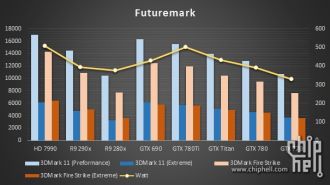
In the 3DMark 11 and Fire Strike benchmarks, the card can boast the highest performance among 1-processor models and slightly lower than the 2-processor GeForce GTX 690. Its power consumption is one of the highest in the list.
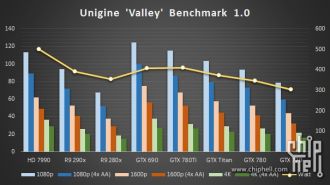
The situation is similar in the Unigine Valley benchmark, although the 780 Ti in most modes is ahead of the 2-processor Radeon HD 7990. In this case, the power consumption is similar to the GeForce GTX 690.
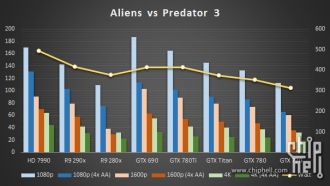
What is the situation in Alians vs Predator 3? GeForce GTX 780 Ti offers the highest animation smoothness of all models with a single GPU, and its power consumption is similar to the GeForce GTX 690 or Radeon R9 290X.
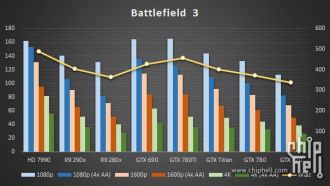
It is even better in Battlefield 3, where in the case of lower graphics settings it is equal to the 2-processor GeForce GTX 690 model. However, power consumption is one of the highest in the list.
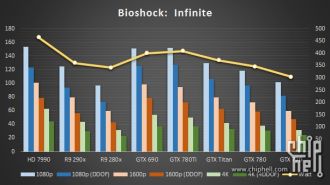
The situation is similar in BioShock: Infinite – GeForce GTX 780 Ti in most modes can match 2-processor accelerators, and its “appetite” for electricity is similar to GeForce GTX 690.
All signs in heaven and earth indicate that the Nvidia GeForce GTX 780 Ti graphics card will be released soon . The Galaxy company revealed the final specification of this accelerator.
GeForce GTX 780 Ti is based on the full Kepler GK110 graphics processor, so offering 2880 CUDA cores, 240 texturing units and 48 rasterization units. In addition, there are 3 GB of GDDR5 memory with a 384-bit interface on board. Standard timings are 876 MHz (928 MHz in Boost 2.0 mode) for the graphics chip and 7000 MHz for video memory.
The reference 780 Ti is cooled by a 2-slot cooler, which consists of an aluminum heat sink with a steam chamber and a turbine blowing it. The whole thing is hidden under an effective housing with a transparent window. A similar solution was used in the reference GeForce GTX 770, 780 and Titan models.
The track provides two DVI outputs, one HDMI and one mini-DisplayPort 1.2, and next to it there are two SLI connectors – thanks to them you can connect up to four such cards in 4-way SLI mode. For proper operation, it is required to connect one 6-pin and one 8-pin additional power plug – the manufacturer recommends using a power supply with a power of at least 600 W (42 A on the 12 V line).
| Model | GeForce GTX 780 | GeForce GTX Titan | GeForce GTX 780 Ti |
| Graphic layout | Kepler GK110 | Kepler GK110 | Kepler GK110 |
| CUDA cores | 2304 | 2688 | 2880 |
| TMUs | 192 | 224 | 240 |
| ROP units | 48 | 48 | 48 |
| GPU clocking | 863/900 MHz | 837/876 MHz | 876/928 MHz |
| Video memory | 3 GB GDDR5 384-bit | 6 GB GDDR5 384-bit | 3 GB GDDR5 384-bit |
| Memory clock | 6008 MHz | 6008 MHz | 7000 MHz |
| Additional power supply | 6+8-pin | 6+8-pin | 6+8-pin |
| DirectX | [email protected] | [email protected] | 11.2 |
| SLI | 3-way | 3-way | 4-way |
| price | $499 | $999 | $699 |
The premiere of the Nvidia GeForce GTX 780 Ti graphics card is scheduled for November 7 , for a price of $ 699 . It is also no secret that it will be the most efficient graphic accelerator of this manufacturer for desktops – however, its compatibility with DirectX 11.2 deserves attention (previous models from the Kepler generation did not offer full support for 11.1 ).
Some time ago we wrote about the Gigabyte GeForce GTX 780 Ti OC card , one of the highest clocked models of this type on the market. The Taiwanese manufacturer, however, claims that it is still not enough and has released an even more curved version of the GeForce GTX 780 Ti .
We are talking about the Gigabyte GeForce GTX 780 Ti GHz Edition model, whose graphics system has been accelerated up to 1085 MHz (1150 MHz in Boost 2.0 mode) – for comparison, its standard clock speeds are only 876 MHz (928 MHz in Boost 2.0 mode). The memory frequency remains intact and is the standard 7000 MHz. The printed circuit board houses the Kepler GK110 graphics processor with 2880 CUDA cores, 3 GB of GDDR5 384-bit memory, and an 8-phase power section.
The accelerator is cooled by the proprietary WindForce 3X system, which can handle up to 450 W of heat. This design consists of two aluminum heat sinks, six copper heat pipes (4x 6 mm and 2x 8 mm) and three fans. The attractive backplate on the reverse of the laminate is also noteworthy.
One DVI-D, DVI-I, HDMI and DisplayPort output are available for monitors. On the upper edge there are two more SLI connectors and two 8-pin additional power sockets – the manufacturer recommends using a power supply with a power of at least 600 W. here.
Specification of the graphics card Gigabyte GeForce GTX 780 Ti GHz Edition:
- core: Kepler GK110
- stream processors: 2880
- core clock: 1085 MHz (1150 MHz in Boost 2.0 mode)
- video memory: 3 GB GDDR5 384-bit
- memory clock: 7000 MHz
- power connectors: 2x 8-pin
- video outputs: DVI-D, DVI-I, HDMI and DisplayPort
- cooling: WindForce 3X





